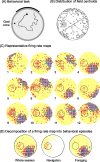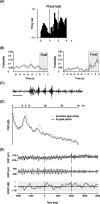Goal-related activity in hippocampal place cells
- PMID: 17234580
- PMCID: PMC6672791
- DOI: 10.1523/JNEUROSCI.2864-06.2007
Goal-related activity in hippocampal place cells
Abstract
Place cells are hippocampal neurons whose discharge is strongly related to a rat's location in its environment. The existence of place cells has led to the proposal that they are part of an integrated neural system dedicated to spatial navigation, an idea supported by the discovery of strong relationships between place cell activity and spatial problem solving. To further understand such relationships, we examined the discharge of place cells recorded while rats solved a place navigation task. We report that, in addition to having widely distributed firing fields, place cells also discharge selectively while the hungry rat waits in an unmarked goal location to release a food pellet. Such firing is not duplicated in other locations outside the main firing field even when the rat's behavior is constrained to be extremely similar to the behavior at the goal. We therefore propose that place cells provide both a geometric representation of the current environment and a reflection of the rat's expectancy that it is located correctly at the goal. This on-line feedback about a critical aspect of navigational performance is proposed to be signaled by the synchronous activity of the large fraction of place cells active at the goal. In combination with other (prefrontal) cells that provide coarse encoding of goal location, hippocampal place cells may therefore participate in a neural network allowing the rat to plan accurate trajectories in space.
Figures








Similar articles
-
Spatial navigation and hippocampal place cell firing: the problem of goal encoding.Rev Neurosci. 2004;15(2):89-107. doi: 10.1515/revneuro.2004.15.2.89. Rev Neurosci. 2004. PMID: 15202682 Review.
-
Changes in goal selection induced by cue conflicts are in register with predictions from changes in place cell field locations.Behav Neurosci. 2007 Aug;121(4):751-63. doi: 10.1037/0735-7044.121.4.751. Behav Neurosci. 2007. PMID: 17663600
-
Local remapping of place cell firing in the Tolman detour task.Eur J Neurosci. 2011 May;33(9):1696-705. doi: 10.1111/j.1460-9568.2011.07653.x. Epub 2011 Mar 14. Eur J Neurosci. 2011. PMID: 21395871
-
Different CA1 and CA3 representations of novel routes in a shortcut situation.J Neurosci. 2008 Jul 16;28(29):7324-33. doi: 10.1523/JNEUROSCI.1909-08.2008. J Neurosci. 2008. PMID: 18632936 Free PMC article.
-
Place cells, grid cells, and the brain's spatial representation system.Annu Rev Neurosci. 2008;31:69-89. doi: 10.1146/annurev.neuro.31.061307.090723. Annu Rev Neurosci. 2008. PMID: 18284371 Review.
Cited by
-
Uncovering the Hippocampal Mechanisms Underpinning Spatial Learning and Flexible Navigation.J Neurosci. 2022 Nov 30;42(48):8915-8917. doi: 10.1523/JNEUROSCI.1400-22.2022. J Neurosci. 2022. PMID: 36450594 Free PMC article. No abstract available.
-
Neural decoding of goal locations in spatial navigation in humans with fMRI.Hum Brain Mapp. 2010 Mar;31(3):391-7. doi: 10.1002/hbm.20873. Hum Brain Mapp. 2010. PMID: 19722170 Free PMC article.
-
The frequency of hippocampal theta rhythm is modulated on a circadian period and is entrained by food availability.Front Behav Neurosci. 2015 Mar 11;9:61. doi: 10.3389/fnbeh.2015.00061. eCollection 2015. Front Behav Neurosci. 2015. PMID: 25814943 Free PMC article.
-
Spatial Learning Drives Rapid Goal Representation in Hippocampal Ripples without Place Field Accumulation or Goal-Oriented Theta Sequences.J Neurosci. 2022 May 11;42(19):3975-3988. doi: 10.1523/JNEUROSCI.2479-21.2022. Epub 2022 Apr 8. J Neurosci. 2022. PMID: 35396328 Free PMC article.
-
Spatial memory deficits in Alzheimer's disease and their connection to cognitive maps' formation by place cells and grid cells.Front Behav Neurosci. 2023 Jan 12;16:1082158. doi: 10.3389/fnbeh.2022.1082158. eCollection 2022. Front Behav Neurosci. 2023. PMID: 36710956 Free PMC article. Review.
References
Publication types
MeSH terms
Grants and funding
LinkOut - more resources
Full Text Sources
Other Literature Sources
